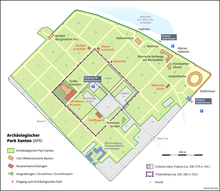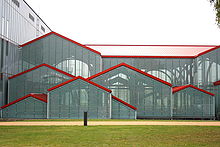LVR Archaeological Park Xanten

The Xanten Archaeological Park ( APX ) is an open-air museum near Xanten on the Lower Rhine ( North Rhine-Westphalia ). The responsible body is the Landschaftsverband Rheinland (LVR), which decided to found the park in 1973. It was opened in 1977 and has expanded repeatedly since then.
The park lies above the former Colonia Ulpia Traiana (CUT), one of the most important Roman settlements in Germany. There is permanent excavation in the park in order to record and research the ground monuments. For this purpose, a so-called summer academy was set up, which offers students the opportunity to get to know the practice of archaeological work.
In order to give the park visitors an impression of the appearance of the Colonia, some Roman buildings were reconstructed or at least partially rebuilt. These include parts of the representative city wall of Colonia Ulpia Traiana , the so-called port temple , the Roman hostel and the city's amphitheater . The structure of the planned Colonia was a checkerboard pattern ; this makes the paths and avenues in the park recognizable.
For a long time the Regional Museum Xanten (RMX) was located in the city center of Xanten. This was finally integrated into the protective structure of the thermal baths and, as a result, renamed LVR-RömerMuseum Xanten in 2008 . Exhibits from local and regional Roman history are shown.
history
prehistory
The Colonia Ulpia Traiana was about 73 hectares in size, had around 10,000 inhabitants and was one of the central cities of the province of Lower Germany . On the east side of the city, on a now silted branch of the Rhine (now a parking lot), the city's previously unexcavated port was located. The city was supplied with fresh water via groundwater wells , rain-catching basins and an aqueduct , while the sewage was channeled into the arm of the Rhine via an underground sewer system. In addition to the harbor, the city had a hostel, covered sidewalks, a temple at the harbor, the Capitol temple, a matron temple , a forum, an amphitheater and a large thermal baths. In 275 it was almost completely destroyed by the Franks and later rebuilt in a smaller form as the most important fortress on the Lower Rhine with the name Tricensimae . At the beginning of the 5th century, however, the attacks by Germanic tribes increased so much that the settlement was finally abandoned.
Since the medieval Xanten was built on a Roman cemetery, the ruins of the Roman city were initially used as a quarry for the construction of the medieval city. The areas that were gradually freed from ruins were finally converted into arable land. Interest in Roman history arose around the second half of the 16th century. The Niederrheinische Altertumsverein carried out systematic excavations on the area in the 19th century . Parts of the city fortifications and the capitol as well as 1500 graves were found. In 1887 the first traces of the amphitheater were discovered, as a farmer got stuck on the underground remains while plowing.
In 1930 the federal highway 57 was built near Xanten. In the course of the construction work, the Rheinisches Landesmuseum Bonn carried out emergency excavations along the route. In 1934, major planned excavations began, during which a silted-up arm of the Rhine was discovered in the east of the Roman city and the amphitheater was completely exposed, preserved and opened for inspection.
The first excavations after the Second World War took place in 1957, as the city wanted to set up a concrete industrial plant on parts of the previously agriculturally used area of the Colonia. During these excavations, the large thermal baths, the craftsmen's and commercial districts, some streets and a building complex with an unknown function were excavated and documented. Then the remains were partially removed and then built over.
Around 1970 the plan was to dig out the old Rhine arm next to the former Roman town and to build recreational facilities in the vicinity of the resulting water and the amphitheater. This would have destroyed the previously untouched eastern part of the Roman city, including the port. But the idea was rejected. In addition, the city of Xanten decided not to expand the existing industrial area between the city, the B 57 and the Rhine and to relocate the companies there so that the areas there were free for the construction of the APX.
Establishment and development of the park
On September 14, 1973, the landscape committee of the Rhineland Regional Association (LVR) decided to set up the park on the site of the former Colonia, for which the LVR was used as a sponsor the following month. The construction of the park began a little later in the vicinity of the amphitheater, while the remaining areas were used for agriculture until 1974. The south-eastern 6 hectare part of the park was finally opened after four years on June 8, 1977.
The organization of the State Horticultural Show in 1980 had been heatedly discussed in advance, as it was feared that this could damage the remains of the Colonia underground. After the concerns had been dispelled, the state horticultural show finally took place from June 4 to June 17, 1980 under the motto “The use and ornamental value of the plant in two millennia”. With the opening of the state horticultural show, the park was expanded from 6 to 27 hectares and thus covered the entire eastern part of the city. After the end of the garden show, many gardens were removed again, only the rock garden and the playground, which was also built for the state garden show, remained, although the playground was renewed in 2003. For many years up until 2002, the building researcher Gundolf Precht was the director of the archaeological park .
After the relocation of the industry located on the area of the Große Thermen , these were finally exposed and roofed over with a protective glass structure in 1999, which mimics the dimensions of the main building with the exception of the vestibule. For many years this protective structure was a kind of museum in its own right, as it was separated from the rest of the park by the B 57. This seclusion ended with the relocation of the regional museum in 2007 to the newly built protective structure above the thermal entrance hall, whereby the thermal springs were integrated into the regional museum, now known as the Roman Museum (opened on August 16, 2008).
After the official opening of the last section of the north-west bypass on December 21, 2008, the B 57, which had previously divided the Roman city, was finally relocated. The celebratory expansion of the park to the previously separated area took place on May 15, 2009, which means that the park now covers an area of 60 hectares. To connect the old park area with the extension, in which the Roman Museum is also located, initially only the old B 57 in the area of the confluence with Trajanstraße was pierced and the connecting road between the port and Maastor was rebuilt.
A little later, the B 57 was also pierced for the continuation of the road south of the Roman hostel , which now connects the area between Siegfriedstrasse and the old B 57 to the park. The actual dismantling of the roads that were added to the APX began in 2011 with the dismantling of the Orwatersweg, the connection between Trajanstrasse and Trajanring near the Große Thermen, Trajanstrasse between APX administration and Siegfriedstrasse and Siegfriedstrasse between Trajanstrasse and the old B 57 followed as well as the old B 57 in the years after. In addition, over 450 linden trees were planted in 2011 and 2012, which trace the ancient three-kilometer-long street course in the extension of the APX and in this way also connect the new area to the old area in terms of design. In November 2013, construction of a visitor center on the former Roman city wall near the amphitheater began at the previous southern side entrance. After its completion at the beginning of 2015, the main entrance from the pier tower, which is located on the side of the park facing away from the city, was relocated to the visitor center in order to better connect the park to the city center of Xanten. The previous side entrance at the Roman Museum and the previous main entrance at the port gate will still be retained. In front of the visitor center on the Am Rheintor street, a new car park was also set up on the area of a petrol station that was demolished in summer 2014.
Management of the park
Martin Müller has been the director of the Archaeological Park since 2003. The further development of the archaeological presentations and the expansion of family-friendly visitor offers is important to him. They play a central role in the so-called development concept of the APX, which he wrote for the expansion of the park. In addition, Martin Müller promotes cooperation with research institutions from home and abroad and is engaged in scientific work on the archeology of the Roman city.
public relation
A small team of archaeologists takes care of the increasingly important public relations work to make the park known and to promote it. Their field of work includes scientific publications of all kinds, designing their own website, photo work and marketing. They also maintain contact with the press, radio and television.
Buildings
The aim of the APX is to make the Colonia Ulpia Traiana visible again. For this purpose, the Roman insulae were planted with lawns, the Roman road network was marked with gravel as far as possible and trees were planted at the distance between the pillars of the pavement roof. In addition, some buildings and parts of the city wall were reconstructed, or the foundation walls of excavated buildings were roofed and released for inspection. In addition, there are house floor plans marked by hornbeam hedges on Insula 32, a playground and, for some years now, the six themed pavilions "Kaiser, Senate & People", "Travel & Traffic", "Windows in the Floor", "Building & Technology", "Bread & Games "," Shipbuilding ". An overview of the structures can be found in the table ( map with all coordinates in the table: OSM ).
![]()
| image | Surname | Type of building | Construction year | location | use | Remarks |
|---|---|---|---|---|---|---|

|
Amphitheater of Colonia Ulpia Traiana | Roman: partial reconstruction | Insula 40 ( location ) |
Events | The amphitheater was not reconstructed on the original foundations, as these were excavated after their discovery in 1887 and were therefore exposed to the weather. Thus the load-bearing capacity was no longer guaranteed. Three of the original pillars' foundations are now on display next to the arena. A replica of a Roman construction crane is also located between the arena and the city wall. | |
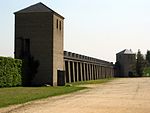
|
City wall of Colonia Ulpia Traiana | Roman: partial reconstruction | at Insula 40 ( location ) |
walkable city wall section | This is the only reconstructed section of the city wall so far. Other parts of the city wall in the old park area are only marked by hornbeam hedges, although the towers have been reconstructed. In the new part of the APX there is no marking of the city wall and the towers. | |
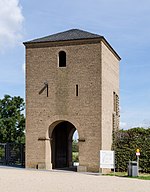
|
reconstructed tower of the CUT (pier tower) | Roman: partial reconstruction | at Insula 37 and 38 ( location ) |
Walkable tower, today the main entrance to the park (the ticket office is in a pavilion in front of it) | the Roman name of the gate is unknown, the modern name of the gate refers to the mole of the Roman port in front of it. The gate probably had a gate passage. | |

|
Reconstructed east gate of the CUT (Great Port Gate) | Roman: partial reconstruction | for Insula 36 and 37 ( location ) |
Walkable gate tower | the Roman name of the gate is unknown, the modern name of the gate refers to the port in front of it. Originally it was assumed that it was an ordinary tower. The reference to the use as a gate was provided by grinding marks on the base. | |

|
reconstructed north main gate of the CUT (Burginatium gate) | Roman: partial reconstruction | at Insula 15 and 22 ( location ) |
Walkable gate system | the Roman name of the gate is unknown, the modern name of the gate refers to the nearest fort Burginatium ( Altkalkar ) | |
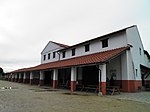
|
reconstructed Roman hostel | Roman: Complete reconstruction | Insula 38 ( location ) |
Exhibition area (in the former Schola), restaurant (on the ground floor of the hostel), rooms for festivities in the "Roman style" | only partially accessible | |

|
reconstructed hostel baths | Roman: Complete reconstruction | Insula 38 ( location ) |
Only partially accessible | The Roman name of the thermal baths is unknown, the modern name refers to the nearby hostel to which the thermal baths belonged. | |

|
reconstructed temple ( harbor temple ) | Roman: partial reconstruction | Insula 37 ( location ) |
Accessible partial reconstruction of the cella, foundation plate | The Roman name of the temple is unknown, the modern name of the temple refers to the nearby port. The temple substructure serves as a protective structure for the exposed foundation plate below | |

|
House floor plans with a Roman grain mill (front) and a Roman oven (back) | Other | Insula 32 ( location ) |
Oven and grain mill for demonstrations | Hornbeam hedges mark the layout of typical Roman townhouses | |

|
Part of an aqueduct (center), milestone (right) | Roman: Original (without protective structure) | Insula 34 ( location ) |
Objects in the open air for viewing | Right next to the game house, a building in which you can play various typical Roman games, there are several original Roman objects, including part of an aqueduct, a milestone and various Roman gravestones | |

|
Sewers | Roman: Original (without protective structure) | in different parts of the park | Objects in the open air for viewing | the canal under the Burginatium gate is accessible, the other canals can be viewed from above through holes in the street | |

|
Capitol foundations | Roman: Original under "normal" protective structure | Insula 26 ( location ) |
Protective structure over the excavated northeast corner of the foundations of the buildings that surrounded the Capitol temple | ||
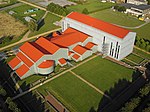
|
LVR-RömerMuseum with thermal protection building | Roman: protective structure in the form of a building | 1999 and 2008 | Insula 10 ( location ) |
Exhibition room in the protective structure above the thermal bath hall | The monumental thermal entrance hall has become the Roman Museum and, together with the thermal protection building, forms a kind of "museum ensemble". You can now visit the thermal baths even better from the museum. |

|
Matron temple | Roman: Original (without protective structure) | Insula 20 ( location ) |
Uncovered foundations outdoors for inspection | Temple District has been within the enlarged park since 2008 | |

|
Roman houses | Roman: Complete reconstruction | 2015 | Insula 39 ( location ) |
Reconstruction of two Roman craftsmen's houses | the houses were faithfully reconstructed on the basis of the found clay foundations, and the interior furnishings were also reconstructed on the basis of the objects found. The reconstruction is carried out to protect the original foundations on a concrete slab poured over it. They were officially opened on April 30, 2015. |

|
Visitor center | Modern building | 2013 (start of construction) | in front of Insula 35 and 40 ( location ) |
Checkout area, shop with 120 m² | Construction of the building began in November 2013, the topping-out ceremony was in April 2014, and the opening was on March 18, 2015. |
Events
On the open-air stages in the reconstructed arena of APX and in the amphitheater of the bearings suburb of the former military camp Vetera in Xanten district Birten directed the "Arena Theater GmbH" annually Xanten Summer Festival from. These are characterized by an annually changing program of musicals and operas and usually take place from June to August.
Due to the success of the summer festival, the APX arena also established itself outside the festival as a venue, especially for concerts , musicals and other events, some of which were broadcast throughout Germany. For example, in June 1984 two concerts by the BAP group were edited together and on June 29, 1991 the first open-air special broadcast of Wetten, dass ..? broadcast on ZDF . In July 2012, ARD used the amphitheater as a backdrop for the full-length game show “Bread and Games” all about Roman history. Bands like Die Ärzte , ZZ Top and Fury in the Slaughterhouse gave several concerts in the amphitheater.
The Landschaftsverband Rheinland has also been organizing the “Day of Encounter” every year since 1998 , which now attracts over 20,000 disabled and non-disabled people to the APX site. The LVR responded to a judgment of the Cologne Higher Regional Court, which, following a lawsuit for noise pollution from a housing estate of disabled people, had determined that the 'annoyance factor' is particularly high "with the noises made by the mentally handicapped residents . For “more acceptance and normal coexistence between the disabled and the non-disabled” , the Day of Encounter was then launched, at which, for example, The Prinzen appeared in 2003 .
Since 1989 the Archaeological Park Xanten has organized the “International Archaeological Summer Academy Xanten” (IASX), a teaching excavation in two campaigns, in each of which 15 students mainly from Europe take part.
Every two to three years the Archaeological Park opens its gates for the Roman festival "Swords, Bread and Games", which is the largest of its kind with 500 participants from various European countries. The last event so far took place on June 23 and 24, 2018.
Roman Museum
The "RömerMuseum" is the successor to the "Regional Museum Xanten" (RMX), which was located in the city center of Xanten not far from the cathedral until 2007. The Roman Museum building was erected over the foundations of the Thermarum basilica (vestibule of the great thermal baths) and thus complements the thermal protection building opened in 1999, which was built over the actual bath rooms.
The aim of the building is to present the Roman finds as close as possible to where they were found. Construction on the building, which was planned by the architects Gatermann + Schossig from Cologne based on the Roman building, was in September 2005. The topping-out ceremony took place on May 30, 2006. The museum was opened on August 16, 2008. The exhibition was designed by Atelier Brückner from Stuttgart.
The exhibits of the museum include, in addition to various objects excavated in the CUT, the foundation walls of the thermal baths themselves, which were a branch of the APX until the opening of the Roman Museum, as well as the so-called Batimodus stone . In addition to the permanent exhibition about the CUT, special exhibitions are also shown. From April 24 to August 30, 2009, the exhibition Marcus Caelius - Death in the Varus Battle was dedicated to the officer Marcus Caelius, who died 2000 years earlier in the Varus Battle , and his cenotaph , the Caelius stone, found in Xanten . In 2012 there was an exhibition with photographs by Axel Thünker under the motto Carpe diem .
Scientific advisor and thus director of the Roman Museum was initially Hans-Joachim Schalles . He was temporarily followed by Marcus Reuter in July 2010 and regularly in July 2011 . PD Charlotte Schreiter has been running the museum since December 2012 .
From July 27th to November 25th, 2018, a special exhibition with the title Goods routes / flows of goods trade, logistics and transport was held on the Roman Lower Rhine .
Since the park was expanded in 2009, the museum has also served as a side entrance to the Archaeological Park. It was previously separated from the park by the B57. Since 2019 there has been a new access to the APX and especially to the RömerMuseum on the SW side of the park. There is also a new parking lot there, which enables better accessibility.
See also
- List of insulae and structures in Colonia Ulpia Traiana
- List of European open air museums
- List of Roman museums
literature
- Gundolf Precht : From the Colonia Ulpia Traiana to the Xanten Archaeological Park. In: City of Xanten (ed.): Studies on the history of the city of Xanten 1278-1978, commemorative publication for the 750th anniversary of the city. 2nd unchanged edition. Rheinland-Verlag, Cologne 1983, ISBN 3-7927-0749-7 , pp. 223-228.
- Alice Willitzer: The excavation 80/26 between Insulae 15 and 22 of the Colonia Ulpia Traiana. (= Xantener Reports , Volume 31, Ed .: Martin Müller ), Verlag Philipp Zabern, Mainz 2017, ISBN 978-3-8053-5135-5 .
- Martin Müller , Hans-Joachim Schalles , Norbert Zieling (eds.): Colonia Ulpia Traiana. Xanten and its surroundings in Roman times . Zabern, Mainz 2008, ISBN 978-3-8053-3953-7 .
Web links
- The APX on the website of the Rhineland Regional Association
- Multimedia presentation about the Roman settlement of the Xanten area
- Roman festival "Swords, Bread and Games" on the side of the LVR Archaeological Park Xanten
- Photo of the building of the amphitheater in 1978 (digit.wdr.de)
Individual evidence
- ↑ a b c d Rhineland Regional Association (ed.): Monument to nature. Protection of nature and soil monuments in the Xanten Archaeological Park . Kleve 2003.
- ^ Building - LVR RömerMuseum
- ↑ a b RömerMuseum facts and figures of the building
- ↑ Xanten: The key to everything
- ^ Photo of the pierced B 57 from July 15, 2011
- ↑ The APX is reforesting - RP Online
- ↑ a b Xanten: New APX entrance before the opening of rp-online.de
- ↑ a b Xanten: APX and Xanten are growing together - RP Online
- ↑ APX is getting closer to the city
- ↑ Presentation of the current head of APX on the park's website , accessed on September 8, 2018.
- ↑ Presentation of the current APX public relations workers on the park's website , accessed on September 8, 2018.
- ↑ Reconstruction buildings: Roman houses
- ↑ Reconstructed craftsmen's houses open in the LVR Archaeological Park Xanten - metropoleruhr.de
- ^ LVR Day of Encounter
- ↑ Roman festival "Swords, Bread and Games". In: www.apx.lvr.de. Retrieved June 25, 2018 .
- ^ Archive of the special exhibitions in the RömerMuseum Xanten
- ↑ Decision made: Marcus Reuter takes over management of the Rheinisches Landesmuseum Trier . In: Trierischer Volksfreund online from April 16, 2012
- ↑ Landschaftsverband Rheinland (LVR) Kultur und Umwelt Newsletter LVR-Kultur from February 1, 2013 ( Memento from July 14, 2014 in the Internet Archive )
- ↑ Goods routes - goods flows. Trade, logistics and transport on the Roman Lower Rhine , edited by Christoph Eger, Xantener Reports Volume 32, Ed .: Martin Müller , Philipp von Zabern Verlag, Darmstadt / Mainz 2018, ISBN 978-3-8053-5174-4


